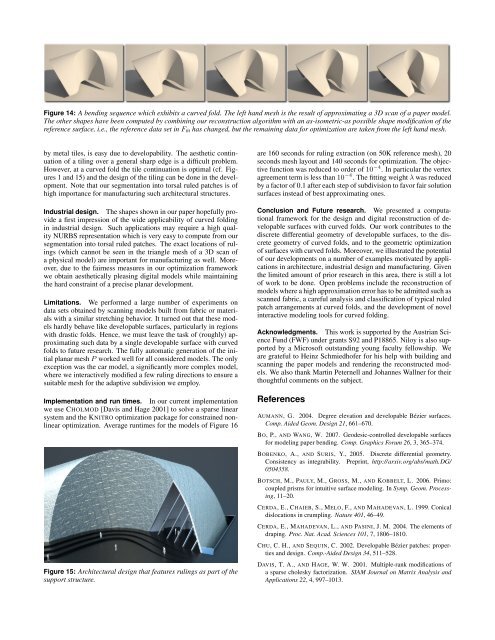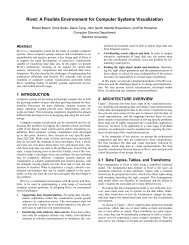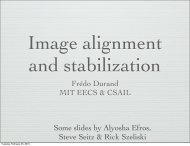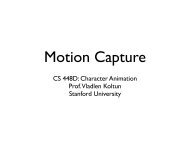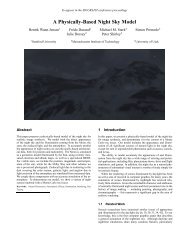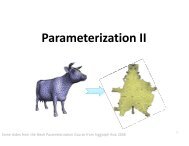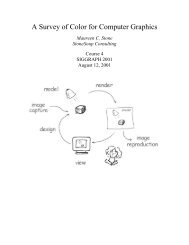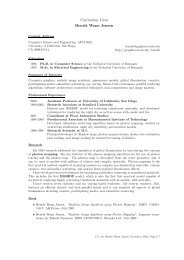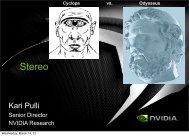Curved Folding - Computer Graphics Laboratory
Curved Folding - Computer Graphics Laboratory
Curved Folding - Computer Graphics Laboratory
You also want an ePaper? Increase the reach of your titles
YUMPU automatically turns print PDFs into web optimized ePapers that Google loves.
Figure 14: A bending sequence which exhibits a curved fold. The left hand mesh is the result of approximating a 3D scan of a paper model.<br />
The other shapes have been computed by combining our reconstruction algorithm with an as-isometric-as possible shape modification of the<br />
reference surface, i.e., the reference data set in Ffit has changed, but the remaining data for optimization are taken from the left hand mesh.<br />
by metal tiles, is easy due to developability. The aesthetic continuation<br />
of a tiling over a general sharp edge is a difficult problem.<br />
However, at a curved fold the tile continuation is optimal (cf. Figures<br />
1 and 15) and the design of the tiling can be done in the development.<br />
Note that our segmentation into torsal ruled patches is of<br />
high importance for manufacturing such architectural structures.<br />
Industrial design. The shapes shown in our paper hopefully provide<br />
a first impression of the wide applicability of curved folding<br />
in industrial design. Such applications may require a high quality<br />
NURBS representation which is very easy to compute from our<br />
segmentation into torsal ruled patches. The exact locations of rulings<br />
(which cannot be seen in the triangle mesh of a 3D scan of<br />
a physical model) are important for manufacturing as well. Moreover,<br />
due to the fairness measures in our optimization framework<br />
we obtain aesthetically pleasing digital models while maintaining<br />
the hard constraint of a precise planar development.<br />
Limitations. We performed a large number of experiments on<br />
data sets obtained by scanning models built from fabric or materials<br />
with a similar stretching behavior. It turned out that these models<br />
hardly behave like developable surfaces, particularly in regions<br />
with drastic folds. Hence, we must leave the task of (roughly) approximating<br />
such data by a single developable surface with curved<br />
folds to future research. The fully automatic generation of the initial<br />
planar mesh P worked well for all considered models. The only<br />
exception was the car model, a significantly more complex model,<br />
where we interactively modified a few ruling directions to ensure a<br />
suitable mesh for the adaptive subdivision we employ.<br />
Implementation and run times. In our current implementation<br />
we use CHOLMOD [Davis and Hage 2001] to solve a sparse linear<br />
system and the KNITRO optimization package for constrained nonlinear<br />
optimization. Average runtimes for the models of Figure 16<br />
Figure 15: Architectural design that features rulings as part of the<br />
support structure.<br />
are 160 seconds for ruling extraction (on 50K reference mesh), 20<br />
seconds mesh layout and 140 seconds for optimization. The objective<br />
function was reduced to order of 10 − 4 . In particular the vertex<br />
agreement term is less than 10 − 4 . The fitting weight λ was reduced<br />
by a factor of 0.1 after each step of subdivision to favor fair solution<br />
surfaces instead of best approximating ones.<br />
Conclusion and Future research. We presented a computational<br />
framework for the design and digital reconstruction of developable<br />
surfaces with curved folds. Our work contributes to the<br />
discrete differential geometry of developable surfaces, to the discrete<br />
geometry of curved folds, and to the geometric optimization<br />
of surfaces with curved folds. Moreover, we illustrated the potential<br />
of our developments on a number of examples motivated by applications<br />
in architecture, industrial design and manufacturing. Given<br />
the limited amount of prior research in this area, there is still a lot<br />
of work to be done. Open problems include the reconstruction of<br />
models where a high approximation error has to be admitted such as<br />
scanned fabric, a careful analysis and classification of typical ruled<br />
patch arrangements at curved folds, and the development of novel<br />
interactive modeling tools for curved folding.<br />
Acknowledgments. This work is supported by the Austrian Science<br />
Fund (FWF) under grants S92 and P18865. Niloy is also supported<br />
by a Microsoft outstanding young faculty fellowship. We<br />
are grateful to Heinz Schmiedhofer for his help with building and<br />
scanning the paper models and rendering the reconstructed models.<br />
We also thank Martin Peternell and Johannes Wallner for their<br />
thoughtful comments on the subject.<br />
References<br />
AUMANN, G. 2004. Degree elevation and developable Bézier surfaces.<br />
Comp. Aided Geom. Design 21, 661–670.<br />
BO, P., AND WANG, W. 2007. Geodesic-controlled developable surfaces<br />
for modeling paper bending. Comp. <strong>Graphics</strong> Forum 26, 3, 365–374.<br />
BOBENKO, A., AND SURIS, Y., 2005. Discrete differential geometry.<br />
Consistency as integrability. Preprint, http://arxiv.org/abs/math.DG/<br />
0504358.<br />
BOTSCH, M., PAULY, M., GROSS, M., AND KOBBELT, L. 2006. Primo:<br />
coupled prisms for intuitive surface modeling. In Symp. Geom. Processing,<br />
11–20.<br />
CERDA, E., CHAIEB, S., MELO, F., AND MAHADEVAN, L. 1999. Conical<br />
dislocations in crumpling. Nature 401, 46–49.<br />
CERDA, E., MAHADEVAN, L., AND PASINI, J. M. 2004. The elements of<br />
draping. Proc. Nat. Acad. Sciences 101, 7, 1806–1810.<br />
CHU, C. H., AND SEQUIN, C. 2002. Developable Bézier patches: properties<br />
and design. Comp.-Aided Design 34, 511–528.<br />
DAVIS, T. A., AND HAGE, W. W. 2001. Multiple-rank modifications of<br />
a sparse cholesky factorization. SIAM Journal on Matrix Analysis and<br />
Applications 22, 4, 997–1013.


